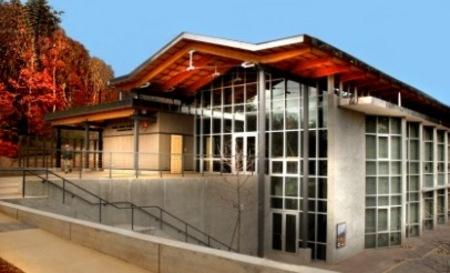To encourage low-impact, eco-friendly operations, the National Park Service presents Environmental Achievement Awards each year to parks and concession companies that have excelled in incorporating high environmental standards into their operations. The award criteria emphasize sustainable design as well as systems and programs promoting energy efficiency, water conservation, materials recycling, and other earth-friendly, cost-saving features.
The 2007 award winners were Blue Ridge Parkway, Yosemite National Park, Delaware North Companies Parks and Resorts, and Xanterra Parks & Resorts.
Park Service Director Mary Bomar congratulated the winners for their progress towards sustainable design, recycling, and energy efficiency. “Their accomplishments provide a roadmap for success in environmental leadership as we prepare for the NPS Centennial in 2016.”
Blue Ridge Parkway Destination Center Design Team won an Environmental Achievement Award for the park’s new $9.8 million Destination Center, which is situated at Milepost 384 on the parkway about eight miles east of downtown Asheville, North Carolina. The distinctive-looking building (see accompanying photo), which was constructed according to Leadership in Energy and Environmental Design (LEED) certifications standards, has a passive solar heating and cooling system that incorporates a “green” roof, radiant floor heating, and related energy-efficient features. Abundant windows provide daylighting that minimizes the need for electrical lights. Energy savings were expected to be 40% in the first year.
The Environmental Achievement Award presented to Yosemite National Park Curry Village Design Team was in recognition of the sustainable design features of the new employee housing complex for Curry Village (which implements Yosemite Valley Plan replacement of facilities destroyed in the 1997 flood). The design of the new complex incorporates exemplary site selection, mechanical systems, lighting, and water efficiency features.
Delaware North Companies Parks and Resorts received its award for the recycling programs it operates at two of the park system’s flagship parks – Yellowstone and Yosemite. In 2007 the programs diverted approximately 1,589 tons of materials from the solid waste streams of the two parks. Delaware North uses GreenPath®, its Environmental Management System (EMS), to provide recycling training for more than 2,400 seasonal employee-associates each year.
Xanterra Parks & Resorts was recognized for the planning and construction of a one-megawatt solar photovoltaic system in Death Valley National Park. The system will generate more than one-third of the electricity that Xanterra needs for its operations at Death Valley while reducing greenhouse gas emissions by more than 30 percent.
The Honorable Mention winners for 2007 were:
• The transit implementation team from Glacier National Park;
• The sustainability program from Glacier Bay National Park and Preserve;
• The recycling and green purchasing program from Big Bend Resorts, LLC (at Big Bend National Park); and
• The food kiosk construction project from Guest Services, Inc. (at National Mall and Memorial Parks).
Hearty Traveler congratulations to the winning parks and concessioners. It’s great to see them putting sustainable earth principles into action.




Comments
Most of the greening-initiatives mentioned in this post seem like commendable recognition for doing what's basically only right, but certainly will benefit from the encouragement & reinforcement.
(At my logging camp on the reknown black bear haven of Kuiu Island of Southeast Alaska, there was strenuous competition for the duty of taking garbage to the informal dump - an operation straight out of the Yellowstone bear-feeding playbook. Throughout the Far North, open dumps conditioned bears to seek out home trash-cans, incinerator-barrels, compost-piles and even fertilized garden-plots - often leading to destructive and sometimes dangerous bear-visitation at folks' homes. They knew dump-feeding led to bear-invasions, but it took a long time - and 'intervention' - for northern communities to finally break the bear-dump link.)
What did raise questions for me, is the citation of somebody called Xanterra, for building a power-generating plant in(?) Death Valley Park. I tried Xanterra's own website, but it's for somebody with broadband to check out. However, the Wikipedia entry about the company provides a good first pass on their background.
While photovoltaic electrical power generation is a good step forward (once it becomes economical on meaningful scales - which escalating fossil-fuel prices bring closer!), I have to think it would still be preferable not to site such facilities within National Parks. I furthermore have the hunch that if it were I or you who wanted to erect some technological activity within a Park, nobody would even talk to us. What does Xanterra have going here, that their power plant construction project gets sited in the Park? Wouldn't it be 'greener' to put it outside the Park?
On the whole, though, I agree: our National Parks have a natural role in promoting the generalized 'green ethic'. Sorting garbage, solar heating, fuel-efficient vehicles and more can & should be showcased, and rewarded with public kudos.
Ted, Xanterra has the in-park concessions in several national parks. I have stayed in their Old Faithful SnowLodge and Mammoth cabins in Yellowstone and eaten at several of their restaurants & snack shops in that park. They do an exceptional job on recycling and low-energy use. They not only practice what they preach but also do educational work in the process.